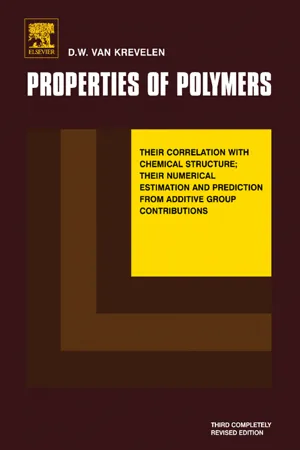
- 898 pages
- English
- ePUB (mobile friendly)
- Available on iOS & Android
Properties of Polymers
About This Book
Properties of Polymers: Their Correlation with Chemical Structure; Their Numerical Estimation and Prediction from Additive Group Contributions summarizes the latest developments regarding polymers, their properties in relation to chemical structure, and methods for estimating and predicting numerical properties from chemical structure. In particular, it examines polymer electrical properties, magnetic properties, and mechanical properties, as well as their crystallization and environmental behavior and failure. The rheological properties of polymer melts and polymer solutions are also considered. Organized into seven parts encompassing 27 chapters, this book begins with an overview of polymer science and engineering, including the typology of polymers and their properties. It then turns to a discussion of thermophysical properties, from transition temperatures to volumetric and calorimetric properties, along with the cohesive aspects and conformation statistics. It also introduces the reader to the behavior of polymers in electromagnetic and mechanical fields of force. The book covers the quantities that influence the transport of heat, momentum, and matter, particularly heat conductivity, viscosity, and diffusivity; properties that control the chemical stability and breakdown of polymers; and polymer properties as an integral concept, with emphasis on processing and product properties. Readers will find tables that give valuable (numerical) data on polymers and include a survey of the group contributions (increments) of almost every additive function considered. This book is a valuable resource for anyone working on practical problems in the field of polymers, including organic chemists, chemical engineers, polymer processers, polymer technologists, and both graduate and PhD students.
Frequently asked questions
Information
Table of contents
- Cover image
- Title page
- Table of Contents
- Copyright
- Inside Front Cover
- FROM THE PREFACE TO THE FIRST EDITION (1972)
- FROM THE PREFACE TO THE SECOND EDITION (1976)
- PREFACE TO THE THIRD EDITION (1990)
- ACKNOWLEDGEMENTS
- Part I: General introduction: A bird’s-eye view of polymer science and engineering
- Part II: Thermophysical properties of polymers
- Part III: Properties of polymers in fields of force
- Part IV: Transport properties of polymers
- Part V: Properties determining the chemical stability and breakdown of polymers
- Part VI: Polymer properties as an integral concept
- Part VII: Comprehensive Tables
- Indexation